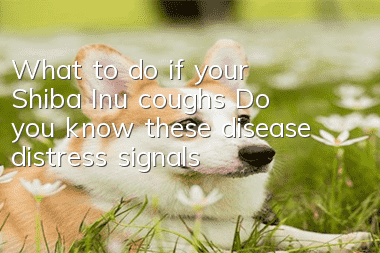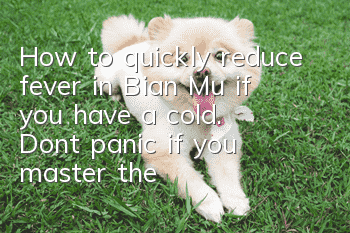What to do if your Shiba Inu coughs? Do you know these disease distress signals?

You need to tell whether a Shiba Inu cough is a cold or not
Cold symptoms: Lack of energy, lethargy, body temperature rising above 40°, cold extremities; heavy and rapid breathing, coughing, and sneezing , watery eyes, watery nasal mucus gradually turning purulent, eyes photophobic; rarely take the initiative to eat. The symptoms are very similar to canine distemper, but different from canine distemper.Treatment methods: Go to the pet store to buy anti-inflammatory drugs to prevent secondary infections; feed the pet Ganmao Ling granules, pay attention to keeping warm and cold, and do not bathe the Shiba Inu during the cold.
Shiba Inu cough is caused by foreign objects stuck in the throat
For example, when playing with toys or chewing bones, if the Shiba Inu accidentally swallows the toy or broken bones, it is very likely to cause a blockage. If the Shiba Inu's throat is blocked, coughing, retching, and scratching of its own mouth or neck will occur. Once the owner discovers that he needs to check the situation immediately, he should quickly remove the foreign object if it can be taken out. If it is stuck too deep, he needs to go to the hospital.Shiba Inu cough requires deworming
Symptoms: Cough, loss of appetite, weight loss, pale or cyanotic conjunctiva, significant loss of appetite, difficulty breathing, edema of limbs, paroxysms Sexual cough, some skin itching, papules, hair loss, etc. Possible infection with heartworm, Toxoplasma gondii,Treatment: Get to the doctor as soon as possible.
Preventive measures:1. It is forbidden to feed pets raw meat, milk, raw eggs or animal organs containing Toxoplasma gondii.
2. Take measures to eliminate mosquitoes and regularly deworm the dog internally and externally.
Canine distemper needs to be ruled out for Shiba Inu cough
Symptoms: The dog has a dry nose accompanied by fever, and the body temperature reaches 39.5-41 degrees, tears, purulent nasal discharge, mental, Loss of appetite, sneezing, and diarrhea will automatically recover after 2-3 days. After 3-14 days, the body temperature will rise again and the clinical symptoms will worsen. In the middle and late stages of canine distemper, swelling of the foot pads, thickening of the cuticle, and cracking will occur. In some cases, acne-like rashes the size of rice grains to bean grains appear under the abdomen and inside the buttocks. They initially appear as blisters, then turn into pus, and finally dry up and fall off. Canine distemper test paper can be used for diagnosis.Treatment methods: The best time for treatment is the early stage of the disease. If neurological symptoms appear later, comfort is generally recommended.
There is no specific treatment in the early stage. Go to the veterinary hospital for treatment with antiviral serum, antibiotics, etc., and get vaccinated in time. The treatment duration should be more than 21 days. During this period, you need to strengthen the care of the dog to avoid catching cold in the bath. No more treatment within a month. Relapse is basically considered a cure.
Shiba Inu cough may be bronchial inflammation
Symptoms:Severe dry cough at the beginning, then turns to wet cough, and in severe cases, spasmodic cough, especially in the morning, vomiting begins after coughing; watery or purulent nasal discharge; accompanied by fever, shortness of breath, mucous membrane Cyanosis and other systemic symptoms.Treatment methods: Take X-ray examination, relieve cough, antibacterial and anti-inflammatory. During treatment, prevent colds from aggravating the condition again.
Pneumonia needs to be ruled out for Shiba Inu cough
Symptoms: The symptoms of pneumonia are similar to bronchitis, but more serious than bronchitis. Generally, symptoms include loss of energy and appetite accompanied by fever above 40°C, severe cough, dehydration, unwillingness to stand, dry nose, and runny nose, which first becomes watery and then turns into pus. Sometimes rust-colored nasal fluid can be seen, and severe pain is often present. Sexual cough; shortness of breath, accompanied by obvious abdominal breathing, especially characterized by a severe wet cough that makes a "cough" sound (wheezing), and sometimes no sound, usually after continuous coughing Nausea makes me want to vomit.Treatment methods: (Penicillin, streptomycin or other drugs are antibacterial and anti-inflammatory. If you have foreign body pneumonia, go to the veterinary hospital immediately to expel the foreign body) to reduce inflammation, relieve cough, and reduce phlegm.
Random articles
- What to do if golden retriever tonsillitis occurs? Know these treatments as soon as possible
- What are the functions of dog nutrition cream? How much dog nutrition cream should be fed in a day?
- What causes bloody stools in dogs? You need to understand the causes of bloody stools in dogs.
- What to do if a Golden Retriever has a fever? Quick fever reduction treatment
- Symptoms of Parasitic Infection in Dogs Do you know what happens if your dog is infected with parasites?
- How to choose a golden retriever cub? Do you know these points?
- Dog external parasites. Do you know what dog parasites are divided into?
- How to choose a Labrador puppy? Do you know these points?
- What are the prenatal signs for a Czech Terrier? What preparations should be made for a Czech Terrier before giving birth?
- How to deal with postpartum lochia in Czech Terrier. How to deal with postpartum lochia in Czech Terrier.



